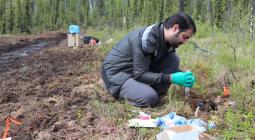Flesh eating parasites multiplying across US due to climate crisis

Experts say it is now endemic to US states like Texas and Oklahoma.
Experts have warned that climate crisis and land-use changes could be creating a conducive environment for flesh-eating leishmania parasites to infect more people in the US.
Numerous studies by climate researchers across the world have already highlighted the increasing risk of insect and pest-borne tropical diseases spreading to temperate and colder parts of the world like Europe and parts of the US with rising global temperatures.
As the climate crisis continues, scientists say tropical parasites, such as the one that causes leishmaniasis, may gain more favourable habitats, expanding access to immunologically naive hosts, and may even develop longer and more intense transmission seasons.
The leishmania parasites are transmitted to humans through the bite of sand flies, which themselves are infected by mammals like rodents when the insects feed on their blood.
The parasitic disease leishmaniasis, characterised by crater-like ulcers with a thick, yellowish pus coat, was well-known to be a tropical infection, affecting people in countries such as Brazil, Mexico and India, but now experts say it is endemic to US states like Texas and Oklahoma, with the potential to extend to Canada in the future.
While the predominantly infectious species of the parasite in the US, Leishmania mexicana, causes milder symptoms that can heal on its own, scientists say there are also strains that can be life threatening.
For instance, visceral leishmaniasis – also known as kala-azar in India – is fatal if left untreated in over 95 per cent of cases and is characterised by fever, anaemia, weight loss, enlargement of spleen and liver.
Experts say as many as 1.5 to 2 million people contract leishmaniasis annually worldwide, and close to 70,000 die from it.
The disease mostly affects the world’s poor, according to the WHO, and even currently available drugs to treat it miltefosine and amphotericin B can be toxic and expensive without much funding going into the development of better treatments.
“It’s a pretty striking difference for a disease that we used to think of as limited to South America now extending as far north as Canada, potentially within the next several decades,” Bridget McIlwee, an Illinois-based dermatologist, told Undark.
Recent studies have also pointed that there could be a larger number of individuals with asymptomatic leishmaniasis in the US than previously realised.
According to a recent study published in the journal Microorganisms, climate change, widespread use of drugs that suppress the immune system, and the deployment of troops to tropical countries like Iraq and Afghanistan, may lead to “leishmaniasis emerging as a health threat in the US.”
“Climate change, the identification of competent vectors and reservoirs, a highly mobile populace, significant population groups with proven exposure history, HIV, and widespread use of immunosuppressive medications and organ transplant all create the potential for increased frequency of leishmaniasis in the US,” scientists, including John Curtin from Walter Reed National Military Medical Centre in the US, noted in the research.
A 2010 study by scientists, including those from the University of Texas at Austin, involving hours of fieldwork catching sand flies and rodents in the state to pinpoint the species’ range, predicted that the collective habitat of the rodents, flies and the parasites in the US would extend to Oklahoma, Kansas, Arkansas and Missouri by 2020.
Even with conservative estimates, “limiting vector and reservoir species occupancy to only the top 10 per cent of their potential suitable habitat,” they said the expected number of human individuals exposed to leishmaniasis could double by 2080 from the 2010 figures.
As climate change continues to push rodent and sand fly habitats northward, scientists warn that more people in the US could be exposed to different species of the flesh-eating parasite, likely expanding even as far as southern Canada.
June 2021
INDEPENDENT




